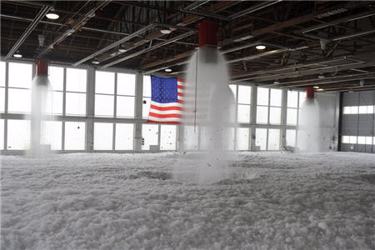The finding comes after a separate analysis showed that companies are exploiting a Trump-era loophole to avoid reporting PFAS pollution.
By Julia Conley Published 10-12-2022 by Common Dreams

PFAS foam. Photo: Water Online
The authors of a new study showing that tens of thousands of sites across the United States are believed to be contaminated by per- and polyfluoroalkyl substances, often called “forever chemicals,” warned that their findings likely vastly underestimate the prevalence of the chemicals, because they’re used in so many products.
Scientists at Northeastern University in Boston led the study, which was published Wednesday in Environmental Science & Technology Letters and identified 57,412 sites where per- and polyfluoroalkyl substance (PFAS) contamination is presumed.
“Forever chemicals”—so named because they do not break down and instead remain in the environment and people’s bodies for decades—are especially likely to pollute areas where firefighting foam is discharged, such as military bases and airports.
The researchers used Northeastern’s contamination site tracker, developed by the university’s PFAS Project Lab, to validate more than 500 sites where PFAS contamination was presumed to be.
They also developed a “presumptive contamination” model to determine other sites where forever chemical pollution was highly likely.
More than a quarter of the sites not included by the PFAS Project Lab’s tracker were places that are not typically associated with PFAS, including restaurants, car washes, and textile cleaners. In addition to substances used at industrial sites, PFAS are often found in household items.
Of the 503 known contamination sites, reads the study, “176 (35%) were observed in the map, and another 187 (37%) were expected by the [presumptive contamination] model but were not mapped due to data limitations, bringing the total validation accuracy to 72%.”
The researchers’ model identified 49,145 industrial facilities, 4,255 wastewater treatment plants, 3,493 current or former military sites, and 519 major airports as places where contamination is likely. PFAS exposure has been linked to several cancers, thyroid disease, and other health problems.
“While it sounds scary that there are over 57,000 presumptive contamination sites, this is almost certainly a large underestimation,” said study co-author Phil Brown, director of Northeastern University’s Social Science Environmental Health Research Institute, in a statement. “The scope of PFAS contamination is immense, and communities impacted by this contamination deserve swift regulatory action that stops ongoing and future uses of PFAS while cleaning up already existing contamination.”
The study follows recent reports showing that the Environmental Protection Agency (EPA) is likely underestimating the amount of PFAS contamination in U.S. drinking water; that so-called “nontoxic” products for children contain the substances; and that shelves at dollar stores are packed with items containing PFAS.
“As PFAS are found to be harmful at lower and lower levels, it is critically important to identify sources of potential contamination and take steps to protect downstream communities who may be unwittingly exposed,” said David Andrews, Ph.D., a senior scientist at the Environmental Working Group (EWG), in response to the study.
Monica Amarelo, the group’s vice president of media relations, noted that “there are few federal limits on industrial discharges of these forever chemicals.”
Identifying potential dischargers of toxic #PFAS is important because it helps regulators better target future testing and alerts nearby communities to potential risks.
There are few federal limits on industrial discharges of these #ForeverChemicals.https://t.co/S4ZwX4G2tp
— Monica | Subscribe to your local newspaper 📰 🗞 (@MonicaAmarelo) October 12, 2022
In September, EWG released an analysis showing that at least five facilities owned by major U.S. companies including 3M and Dow Chemical are exploiting a regulatory loophole to avoid reporting the amount of PFAS pollution their operations are causing.
Companies have been required since 2020 to report to the EPA the annual release of more than 100 pounds of PFAS, but former Republican President Donald Trump’s administration put in place a loophole “allowing them not to report if PFAS amounts are negligible, defined as less than 1% of a total mixture.”
“The exemption makes it possible for manufacturers to avoid [Toxics Release Inventory] reporting, often by diluting their waste mixtures so the concentration of any single PFAS remains below 1%,” said EWG. “Facilities can therefore avoid reporting, even if they release one or a combination of PFAS in quantities significantly above the 100-pound threshold, so long as each forever chemical makes up less than 1% of the total mixture.”
The loophole could be contributing to the government’s underestimation of the amount of PFAS contamination in the environment.
“Federal regulations limiting discharges into the air and water are urgently needed to turn off the tap at the source,” said Melanie Benesh, EWG’s vice president of government affairs, on Wednesday. “The EPA should move swiftly to set regulations for the industries most likely to be dumping PFAS into the environment. State regulators should also act quickly to incorporate limits on the amount of PFAS that can be released into existing permits.”

